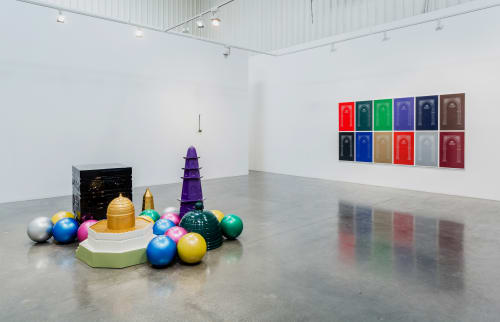Lawrie Shabibi launches the new art season with “Bodies” a solo exhibition by Hamra Abbas, her second at the gallery. Moving effortlessly between a variety of materials, “Bodies” is influenced by her recent move back to her hometown Lahore, relating her distinct experiences and observations of middle-class religious practices in homes and in the city’s public spaces.
At the heart of the exhibition is a new sculpture, the second in her Barakah Gifts series - the first of which is currently being installed at the American Embassy in Islamabad as part of the Art in Embassies programme. Abbas’s Barakah Gifts are large-scale reproductions of commercial souvenirs sold as mementos for pilgrims at the markets adjacent to the two holy mosques. Taking representative images of the holy sites and transforming them into everyday items such as water bottles, paperweights, clocks and plates, many of these trinkets find their way back to the pilgrim’s homes or are distributed as gifts for family and friends. Barakah Gift II, a penholder comprising a colourful composition of shiny minarets, shimmering balls and the Kaaba,is taken from a souvenir she collected whilst on Umrah in 2012. Transformed into an ostentatious and absurdly large installation, it reveals the seductive interplay between commerce and devotion.
In contrast to the boldness of the Barakah Gifts are three woodcarvings that are testaments to the artists’ observance of everyday life in the homes and on the streets of Lahore. Carved from sheesham wood and then painted by the artist, these works are hyperrealist sculptures that create icons out of the ordinary. Plastic Flowers I is an intimate wall-mounted piece taken from a picture she took in her mother-in-law’s house of a portrait with prayer beads and a stalk of plastic flowers hung over the frame. Plastic Flowers II depictsa plastic flower stuck with scotch tape underneath a surveillance camera spotted by the artist in an ATM booth. Bodies on the other hand is a group of intricately carved wooden footwear taken from photos Abbas had taken outside the entrances to holy sites and family homes – a marker of segregation between inside and outside, clean and dirty, sacred and the profane. Each of these sculptures has been timelessly rendered, giving the original mundane objects a weight and presence that goes far beyond the accidental.
Switching from sculpture to photographyis Sweet and Savory, a sentimental photograph of two small piles of rice left on a security barrier at the entrance to Data Darbar, one of the most revered shrines in Lahore and dating back to the 11th Century one of its oldest. Food is distributed here every day for the visitors who come from afar on a daily basis, but the rice on the edge of a security barrier is seemingly for the birds. In recent years social and religious practices at public sites in Pakistan have come under immense threat: in 2010 for example Data Darbar was subject to a terrorist attack which killed scores of people and is currently subject to tightened security. The sweet and savoury rice placed humbly on the security barrier highlights the current state of unease in Pakistan’s devotional sites: of the coexistence of both hospitality and hostility.
Finally in One Rug, Any Colour Abbas uses a selection of coloured nylon prayer rugs bought by her on Amazon. According to the artist prayer rugs depicting the Kaaba have recently fallen out of favour, unlike in the past, when such images on prayers rugs were quite common. Hence finding them in the markets of Lahore today can be impossible. The piece also recalls an incident on Umrah, when a woman handed the artist one in a small bag as she was leaving the Prophets’ Mosque in Medina. Her own personal Barakah gift, this work also continues the artist’s fascination with colour and of representations of the Kaaba, a throwback to her first Lawrie Shabibi show exhibition ‘Kaaba Picture as a Misprint’ in April 2013.

